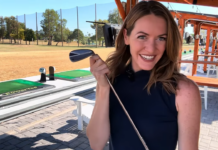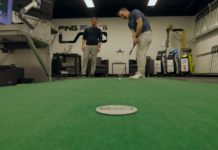Square up and use bounce to master the plugged lie and fried-egg bunker shots
By Jonathan Staton
It’s an all-too-common scenario on the golf course: You’ve hit a seemingly perfect approach after a high, drawing 7-iron into the green, only to see a massive splash of sand from the cavernous bunker guarding the tucked flag. To make things even worse, you then walk up to find your golf ball completely buried near the lip, when just a second before you had high hopes of saving par.
Well, before you relegate yourself to penning that depressing 6, let’s discuss how to give at least some shot at saving a 4 by pinpointing a few, key factors allowing to hit the plugged lie and “fried-egg” bunker shot with success.
Bunker Shots 101: Use the club’s bounce and loft to your advantage
Proper bunker play sometimes eludes even the best amateur golfers, and a plugged lie in the bunker can rattle your game even more. That said, escaping the plugged lie and scrambling for par isn’t as hard as it looks.
To start, it’s important to know exactly how your club interacts with the sand in the bunker. We’ve discussed the importance of using the bounce on your wedge many times on the GolfTEC Scramble, and how it’s crucial to your short game success.
When in a (greenside) bunker, it’s generally best to use a wedge with 55 to 64 degrees of loft and a high amount of bounce (say, 10 degrees or so). This allows the club to easily cut through the sand, rather than dig like a shovel, and loft the ball high enough to land softly on the green.
 With a good lie in the bunker, the ball sits fully on top of the sand so the club’s high degree of loft, extra mass behind its leading edge and bounce angle are able shallow out enough to get the ball (and sand around it) out with enough contact on the clubface for a relatively high degree of control and spin.
With a good lie in the bunker, the ball sits fully on top of the sand so the club’s high degree of loft, extra mass behind its leading edge and bounce angle are able shallow out enough to get the ball (and sand around it) out with enough contact on the clubface for a relatively high degree of control and spin.
Considering a plugged lie, however, the ball sits below the surface of the  sand so the club won’t have as clean of contact with the extra sand between the ball and the clubface.
sand so the club won’t have as clean of contact with the extra sand between the ball and the clubface.
So, as explained below, it’s best to slightly adjust your setup and create a combination of elements from the club’s bounce and “shovel” effect from its leading edge, which is now needed to dig the ball out of the bad lie.
Escaping plugged lies in the bunker

1. Address the ball with a square to slightly open address position, with the clubface square to the target.
As opposed to a shot with a good lie in the bunker, where an open stance and clubface allow its bounce to help it get through the sand with ease, a more square stance and clubface allow just enough of the leading edge to dig through the sand to get to the buried ball, while still using enough of the bounce’s shallowing effects to not dig too much.
2. Shift most of your weight (70 to 80 percent) toward the lead leg.
This will help correctly position the low point of the swing under/ahead of the ball, instead of well behind it — a common fault seen in many higher handicap players.
3 Strike the sand about an inch or two behind the golf ball, making sure to swing free and accelerate through the shot.
It’s important to trust the club’s loft and bounce will do the proper work needed to get the ball out. You may, therefore, notice the need to refrain from “helping” the ball into the air. This is a common fault also leading to the swing’s low point hitting too far behind the ball. This often occurs by pulling your weight back toward the trail foot in the downswing, instead of maintaining it on the lead leg, leading to fat or thin shots from over-active hands (or a “scooping” of the ball), and deceleration.

4. Predict the ball’s outcome, knowing it won’t spin as a much, and account for this in your strategy. As aforementioned, the extra sand between the ball and clubface means it will have less backspin, and likewise less control once it lands. Translation: You may need to play away from that tucked pin! By knowing the shot will roll out farther once it hits the putting surface, you can better strategize where to aim before you hit the shot, allowing for your greatest chance to save that par.
Like golf instruction tips and drills like this? For help with more useful instruction to help you play your best golf this year, contact your local GolfTEC Certified Personal Coach today!










